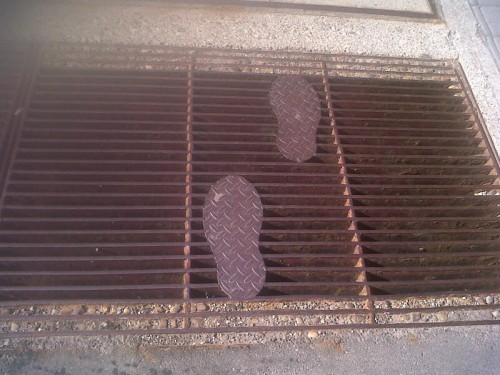Thanks to my friend and fellow author Karen Martin for taking this picture while in Calgary. Even if you don't wear high heeled shoes, I think you can appreciate the attempt at error proofing.
Karen and I both wondered if this modification to the grates was proactive or in response to an incident or injury?
You can also click here to view it via Twitpic.
In your process or organization, how do you strike the balance between error proofing everything, versus prioritizing problems that are most likely to occur or cause the most harm?
What do you think? Please scroll down (or click) to post a comment. Or please share the post with your thoughts on LinkedIn – and follow me or connect with me there.
Did you like this post? Make sure you don't miss a post or podcast — Subscribe to get notified about posts via email daily or weekly.
Check out my latest book, The Mistakes That Make Us: Cultivating a Culture of Learning and Innovation:











Sadly I can’t find any photos now but those against a nanny state would love the sidewalk department in Penang, Malaysia. There are tons of 2 feet by 2 feet (or larger) holes the sidewalk with 4-6 foot drops. I saw at least 10 in my week there.
Sorry, John — the picture is fixed and it should appear now.
This is an amazing one!! The core value behind error proofing (poka yoke) is definitely safety first! Thanks for sharing.
Great post, Mark. Seeing this again got me curious so you know, Nancy Drew here, had to to dig a little deeper. :-)
Turns out the grates are owned by Enmax, the electrical utility in Calgary. The footprints were indeed placed there to protect ladies from getting their high heels caught in the grates. The engineer I spoke with thinks they first started using them in the 50’s. Interestingly, they’re currently in the middle of a kaizen process to make them less slick. Apparently when the city removes snow, the raised anti-skid areas get buffed down. Kudos to Enmax and the City of Calgary for protecting woman’s ankles and their Jimmy Choo’s!
Thanks for the added detail, Karen!
Love the picture! Great example of error proofing. I was just thinking of the many projects we could get wrapped up in while trying to error proof our facilities. I definitely feel there needs to be priorities set when determining where to focus our effort…otherwise we end up running around like chickens with their heads cut off. Safety should always take precedence…but don’t forget to check back to be sure your efforts were sustained! Thanks again!
While it sounds like they were indeed error-proofing, I also have to appreciate the artistic value off having a little added uniqueness here and there to focus people’s attention on what could be a dangerous bit.
Kind of like the variety of messages used to draw attention to the construction zone speed warnings around the US.
Thanks for being (I think) a first-time commenter, Eric. I hope you’ll come back…
On the basis that the solution suits only one path and a specific stride would not a true error proofing solution avoid having a grating in the first place?
Thanks for the pictures. I was talking about Calgary’s safety measures for women in high heals in response to a picture someone posted about the signs near the grates at Stanford – this was the only pic I could find!
(Extra thanks to Karen – I had no idea they were put in by Enmax 60 years ago! That’s fantastic!)
Thanks for sharing the picture. Reduction of accidents is always on top priority. People may refer to kaizen practise to find safe options.